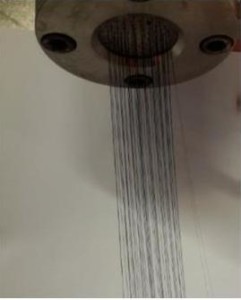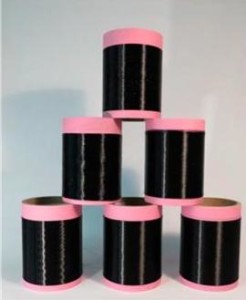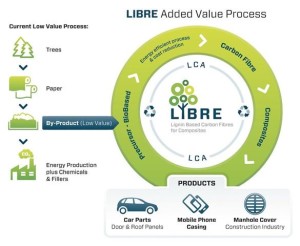
Carbon fibres are considered one the most added value products on the market due to their excellent properties, high stiffness and tensile strength, low thermal expansion and density, heat tolerance and chemical resistance. The use of carbon fibre (CF) based composites is of growing importance in many industrial applications with the total global market estimated at $28Bn. The vast majority of the carbon fibres production is based on Polyacrylonitrile (PAN) that involves high cost and a limited production capability.
For these reasons, developing a new technology able to produce carbon fibres decreasing the cost and guaranteeing the sustainability of carbon fibre production, is crucial for the society.
Lignocellulosic biomass from trees, straw corn cob and other products from agriculture and forestry, is considered as alternative to petroleum based precursor in carbon fibres manufacture. In particular, lignin, which is the most abundant component of lignocellulosic biomass (along with hemicellulose and cellulose), shows enormous potential for carbon fibre production due to its chemical structure. Lignin is amorphous and the only aromatic biopolymer present in the cell walls of pith, roots, fruit, buds and bark, and is currently a non-valorised waste of the paper industry. Previous attempts to process carbon fibre precursor from lignin were unsuccessful because of the brittleness and poor thermoplastic behavior of lignin. Also, with current technology it is impossible to continuously proces lignin as carbon fibre precursor at industrial scale.

For these reasons, the aim of the LIBRE project is to use lignin-rich side streams to develop a more resource-efficient and suitable carbon fiber production technology, based on biopolymers for precursor fibre production (PF) and energy efficient processing technologies for conversion of PF to CF which will have performance levels matching or bettering current industrial standards.
The LIBRE project is defined by four key objectives:
i) Replace PAN PF with a PF made from sustainable bio-source. In particular lignin biopolymer blends are being developed in order to enhance processing to carbon fibre through stabilisation of melt viscosity and melt temperature during the spinning process, thereby providing optimised PF for stabilisation and carbonisation steps in order to efficiently convert PF to CF.
ii) Develop an innovative lower energy conversion process of PF to CF. Currently, the industrial process of CF fibre conversion involves big furnaces with enormous energy consumption. In LIBRE project a novel technology for CF production is being developed. This new process will offers a lower cost and a higher throughput route to CF production, whilst minimizing the environmental impacts and maintaining product quality.
iii) Replace the electrolytic process currently used by industry to modify CF surface. New surface treatments are being proposed to replace current electrolysis and surface coating techniques in order to ensure that the fiber/matrix interface in composite materials maximizes related composite properties.
iv) Incorporate novel ideas into the physical and chemical modification of lignin. Currently, the LIBRE project is focused on chemical and physical modification of lignin in order to tailor its properties for the needs of carbon fibre production.

The LIBRE consortium is led by Dr Maurice N. Collins (the Bernal Institute, School of Engineering, University of Limerick, Ireland) and it consists of: University of Limerick (Ireland), University of Bolton (United Kingdom), Fraunhofer IFAM (Germany), Institut für Verbundwerkstoffe (Germany), Chalmers University (Sweden) Belgian Textile Research Centre (Belgium) Dralon (Germany), Deutsche Institute für Textil- und Faserforschung (Germany), Tecnaro (Germany), C-Tech innovation (United Kingdom), ÉireComposites (Ireland) and Centro Ricerche Fiat (Italy). This international group enables the technology to be developed and implemented on a European scale. The consortium brings together “leaders in the field” which covers the full value chain from raw material producers to end users ensuring successful outcomes for the European bioeconomy. The consortium has already established IP as well as reporting significant scientific output in journals and conferences. For further details see www.libre2020.eu and twitter @libre2020.
LIBRE project has received funding by the Bio-Based Industries Joint Undertaking under the European Union’s Horizon 2020 Research and Innovation Programme under grant agreement No. 720707.
Text by Mario Culebras Rubio, Yan Wang, Anne Mcloughlin and Maurice N Collins, LIBRE project.


